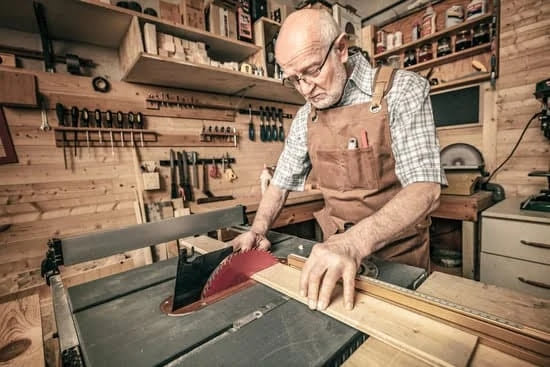Woodworking projects offer a fantastic opportunity for parents or guardians to bond with their children while teaching them valuable skills. In this article, we will explore why woodworking projects are great for kids and how to get started on this exciting journey.
Woodworking not only provides children with a hands-on learning experience, but it also promotes their cognitive and physical development. From honing problem-solving skills to cultivating creativity, woodworking offers a range of benefits that go beyond simply crafting wooden objects.
Engaging in woodworking projects allows children to develop various skills that will serve them well throughout their lives. Through hands-on work, they can learn important problem-solving abilities as they figure out how different pieces fit together and troubleshoot any issues that may arise. Additionally, woodworking encourages critical thinking as children analyze measurements and angles, honing their mathematical and spatial reasoning skills.
Moreover, woodworking projects allow children to express their creativity by designing and customizing their creations. Whether it’s building a birdhouse or crafting a small shelf, children can take pride in seeing their ideas come to life. This hands-on activity also instills a sense of accomplishment, boosting their self-esteem and fostering confidence in their abilities.
In the following sections, we will delve into selecting age-appropriate projects and tools, creating safe work environments, teaching safety rules and basic woodworking skills, choosing engaging projects that capture kids’ interest, involving them in the project planning process, guiding and supervising them effectively throughout the process, and showcasing the proud accomplishments through finishing and displaying the final projects. So let’s jump right in and discover the wonderful world of woodworking projects with kids.
Selecting Age-Appropriate Projects and Tools
When it comes to starting woodworking projects with kids, it is essential to select age-appropriate projects and tools. This ensures that the child can fully engage in the project while also learning new skills. By choosing projects and tools that are suitable for their age and abilities, you can create a positive and enjoyable woodworking experience for children of all ages.
Choosing Projects Based on Age Group
It is crucial to consider the child’s age and skill level when selecting woodworking projects. For younger children, simple projects such as building a bird feeder or a wooden toy can be a great introduction to woodworking. As children grow older, they can tackle more complex projects like building a small bookshelf or a tool caddy.
When choosing projects, keep in mind the time commitment and complexity involved. It is important to select projects that can be completed within a reasonable timeframe, keeping the child’s attention span in mind. Additionally, consider their interests and hobbies when selecting a project; this will help increase their excitement and motivation throughout the woodworking process.
Exploring Kid-Friendly Tools
Alongside age-appropriate projects, it is vital to provide kids with kid-friendly tools that are safe and suitable for their size and strength. There are various options available specifically designed for children’s use, such as small hand saws, hammers, screwdrivers, and sandpaper blocks.
Before introducing any tool to a child, ensure they understand how to properly handle it and emphasize the importance of safety precautions. Supervision is essential during this process to teach them safe tool usage techniques. Gradually introduce more complex tools as they gain experience and confidence in their abilities.
By carefully selecting age-appropriate projects that match the child’s skill level and providing them with suitable tools, you can set the foundation for an engaging woodworking experience that fosters both creativity and skill development in children of all ages.
Creating a Safe and Well-Organized Work Area
When it comes to woodworking projects with kids, creating a safe and well-organized work area is of utmost importance. This section will offer valuable tips on how to set up a dedicated woodworking space for kids, emphasizing safety and proper organization in the workshop.
To begin with, it is crucial to designate a specific area solely for woodworking activities. This can be a corner of the garage or an unused room in the house. The key is to have enough space for the child to comfortably work and move around. Consider investing in a sturdy workbench or table that is at an appropriate height for the child’s age.
Safety should always be a top priority when working with children. Create clear boundaries and establish rules to ensure they understand what is expected of them while in the workshop. Make sure your work area is well-lit, free from any hazards or distractions, and equipped with necessary safety equipment such as goggles, ear protection, and dust masks.
Proper organization plays a crucial role in maintaining a safe and efficient workspace. Utilize storage solutions such as shelves or bins to keep tools, materials, and supplies neatly organized and easily accessible. Take extra care to store sharp tools out of reach from young children when they are not being used.
To maximize space utilization, consider hanging tools on pegboards or using wall-mounted tool racks. This not only keeps everything organized but also reduces clutter on the work surface. Encourage children to clean up after each session by providing designated areas for tools and materials.
By creating a safe and well-organized work area, you are setting the stage for successful woodworking projects with kids. Not only does this ensure their safety but also teaches them valuable skills in organization and responsibility. Remember that regular maintenance of the workspace will help keep it safe for future use as well.
Key points
- Designate a specific area solely for woodworking activities, ensuring enough space for the child to work comfortably.
- Emphasize safety by establishing clear boundaries, providing necessary safety equipment, and keeping the workspace well-lit and free from hazards.
- Utilize storage solutions such as shelves or bins to keep tools and materials organized, and encourage children to clean up after each session.
Teaching Safety Rules and Basic Woodworking Skills
Woodworking Projects: Teaching Safety Rules and Basic Skills
In order to ensure a safe and enjoyable woodworking experience with kids, it is crucial to teach them the proper safety rules and basic woodworking skills. By instilling good practices from the start, children will develop a strong foundation in woodworking techniques while also learning how to prioritize their own safety.
Essential Safety Rules
Before embarking on any woodworking project, make sure to establish a set of safety rules that children should follow at all times. Some important safety guidelines include:
- Always wear the appropriate personal protective equipment (PPE), such as safety goggles, ear protection, and closed-toe shoes.
- Work in a well-ventilated area to minimize exposure to dust and fumes.
- Never rush or work when feeling tired or distracted.
- Keep workspaces clean and organized to prevent accidents caused by tripping or falling over tools or materials.
Basic Woodworking Techniques
Introduce children to the foundational skills they need for working with wood. Help them become familiar with different types of tools and their uses, including hand tools such as saws, hammers, and screwdrivers, as well as power tools like sanders or drills. Teach them proper tool handling techniques, emphasizing the importance of maintaining a firm grip while using tools and keeping fingers clear of blades or cutting surfaces.
Additionally, instruct children on crucial measuring and marking skills using tape measures or rulers. Show them how to make accurate measurements before making cuts or assembling pieces together. Teach them about different types of wood joinery techniques like butt joints or miter joints so they can learn how pieces fit together securely.
Tool Maintenance
Teaching kids about tool maintenance is essential for both their safety and the longevity of the tools themselves. Show children how to care for their tools properly by cleaning them after use, storing them in a designated place, and sharpening blades when necessary. Educate them on the importance of returning tools to their proper places after use to prevent accidents caused by misplaced or mishandled tools.
By focusing on safety rules and basic woodworking skills, children will not only learn how to create beautiful woodworking projects but also develop a strong sense of responsibility and attention to detail. These foundational skills will set them up for success as they continue to explore the world of woodworking.
Getting Kids Excited
When it comes to woodworking projects with kids, selecting engaging and creative projects is key to keeping them excited and motivated throughout the process. By choosing projects that capture their interest and imagination, children are more likely to stay engaged, learn new skills, and feel a sense of accomplishment. Here are some suggestions for choosing the right woodworking projects for kids:
- DIY Step Stool: A simple yet practical project for young children is building a wooden step stool. Not only does it provide them with a useful item for everyday use, but it also allows them to learn basic woodworking skills like measuring, cutting, and assembly.
- Birdhouse: Building a birdhouse is an exciting project that offers children the opportunity to connect with nature while learning about different bird species. They can customize the design and decorate it creatively, turning it into a beautiful addition to any garden or backyard.
- Wooden Toy: Creating their own wooden toy can be a fun and rewarding project for kids of all ages. Whether they choose to make a car, puzzle, or dollhouse furniture, they get to experience the joy of playing with something they built themselves.
To ensure the success of these projects, step-by-step instructions should be provided along with illustrations or diagrams that make it easy for kids to follow along. It’s also essential to encourage creativity by allowing them to customize their projects through painting or adding finishing touches like stickers or decorative elements.
By involving children in the decision-making process regarding project selection, you empower them to take ownership of their creations and boost their enthusiasm for woodworking even further. This fosters creativity, problem-solving skills, and a sense of accomplishment as they see their ideas come to life in tangible ways.
Overall, choosing engaging and creative projects for kids not only makes woodworking enjoyable but also fuels their curiosity and imagination. It provides an excellent opportunity for parents or guardians to bond with their children and create lasting memories together.
Involving Kids in the Project Planning and Design Process
One of the key aspects of involving kids in woodworking projects is allowing them to take an active role in the project planning and design process. By including children in these decisions, they develop decision-making skills and boost their self-confidence. This section will focus on ways to encourage children to participate in project planning, utilize their creative ideas, and incorporate their input into the final project.
When involving kids in the project planning process, it’s important to let them have a say in choosing designs and materials. This allows them to feel a sense of ownership and personal connection with the project. Start by presenting different design options or ideas that align with their interests or hobbies. For example, if your child loves animals, suggest building a wooden birdhouse or animal-shaped bookends.
To further engage them, ask open-ended questions and encourage creative thinking. Let them brainstorm ideas on how they can customize or personalize the project to make it truly unique. This can include ideas for colors, patterns, or additional features they want to incorporate into the design.
Once you have gathered their input, find ways to incorporate their ideas into the final project. It may require some modifications or adjustments on your part as the adult supervisor, but by making room for their creativity and suggestions, you are fostering a sense of collaboration and teamwork.
For younger children who may struggle with verbalizing their ideas, consider providing visual aids such as drawings or sketches that they can use as a reference. This not only helps them articulate their thoughts but also enhances their understanding of spatial relationships and visualization skills.
Involving kids in the project planning and design process not only creates a more meaningful experience but also encourages their creativity and problem-solving abilities. By valuing their input and allowing them to make decisions, you are empowering them to take ownership of their woodworking projects while developing valuable skills for future endeavors.
| Ways to Involve Kids | Benefits |
|---|---|
| Letting them choose designs and materials | Develops decision-making skills and personal connection to the project |
| Encouraging creative thinking and brainstorming | Fosters imagination and problem-solving abilities |
| Providing visual aids for younger children | Enhances spatial relationships and visualization skills |
Guiding and Supervising Kids Throughout the Woodworking Process
Woodworking projects with kids can be a fun and engaging activity, but it is important to provide guidance and supervision throughout the process to ensure their safety and success. As parents or guardians, it is crucial to support children during woodworking projects while also teaching them valuable skills and promoting their independence.
One key aspect of guiding and supervising kids in woodworking projects is establishing clear rules and safety precautions. Before beginning any project, make sure your child understands the importance of wearing protective gear such as safety goggles and gloves. Teach them how to properly handle tools, emphasizing the need for caution and focus. It is also essential to teach them about potential hazards in the workshop environment, such as sharp objects or power tools.
While allowing children to work independently fosters their confidence and decision-making abilities, it is necessary to offer guidance when needed. Be available to answer questions, demonstrate techniques, and provide assistance when required. However, try not to take over the entire project, as it is essential for children to experience a sense of ownership and accomplishment.
Common challenges may arise during woodworking projects with kids, such as frustration or difficulties with certain tasks. To overcome these challenges, approach them positively and patiently. Encourage perseverance and problem-solving skills by helping them break down complex steps into more manageable ones. Additionally, praise their effort throughout the process rather than focusing solely on the end result.
By effectively guiding and supervising kids during woodworking projects, you can create a safe yet stimulating environment that promotes skill development, creativity, and self-confidence.
| Guiding Tips | Supervision Techniques |
|---|---|
| Establish clear rules | Watch for proper tool handling |
| Promote independence while offering assistance when needed | Provide guidance and demonstrations |
| Encourage problem-solving skills | Praise effort and perseverance |
Showcasing the Proud Accomplishments
Finishing and displaying the woodworking projects is a crucial step in the process that allows children to showcase their proud accomplishments. By taking the time to properly finish and treat their projects, children can enhance the overall appearance and durability of their creations.
To begin, it is important to provide clear instructions and guidance on how to finish each project. This might include teaching children about different types of finishes (such as staining, painting, or varnishing) and explaining the steps involved in applying them. Teaching proper techniques will allow children to take pride in their work and create a finished product that they can be proud of.
Additionally, parents or guardians can encourage children to personalize their projects by adding finishing touches. This might include decorative elements such as wood burning, carving intricate details, or adding personalized labels or engravings. By allowing children to add their own creative flair, they will develop a sense of ownership over their projects and feel a true sense of accomplishment.
Once the projects are completed, it is important to find ways to display or share them with others. This can be done by creating a dedicated space in the home where finished projects are proudly displayed. Another option may be gifting completed projects to family members or friends, allowing children to see the joy and appreciation that their creations bring to others.
In conclusion, finishing and displaying woodworking projects is an essential part of the process that allows children to fully appreciate their hard work and dedication. By teaching them how to properly finish their projects and encouraging personalization, children will develop a sense of pride in their craftsmanship. Finding ways to display or share these finished projects will further reinforce this sense of accomplishment and provide motivation for future woodworking endeavors.
Frequently Asked Questions
What should a beginner woodworker make?
For a beginner woodworker, it is important to start with simple and manageable projects that can build foundational skills and confidence. One ideal project for beginners could be a cutting board. It involves basic techniques like measuring, marking, and using a saw to cut the wood into desired dimensions.
It also allows for practicing sanding to achieve smooth surfaces and applying finishes like food-safe oil or wax for protection. Another good option could be a small storage box, which adds additional skills such as making joints, drilling holes for hinges, and installing hardware. These types of projects provide an opportunity to learn fundamental woodworking skills while creating useful items.
What is the best wood for kids projects?
When choosing the best wood for kids’ projects, there are several factors to consider. Safety is paramount, so selecting non-toxic woods that do not contain any harmful chemicals or allergens is crucial. Softwoods like pine or cedar are often recommended for children’s projects due to their ease of use and availability.
They tend to be lighter and easier to work with compared to hardwoods, making them suitable for young woodworkers who may have limited hand strength or experience. Softwoods are also more forgiving in terms of mistakes and allow for easier shaping and sanding. However, it is always important to supervise children when working with any type of tools or materials.
What can children make from wood?
Children can make a variety of things from wood depending on their age, skill level, and available tools. Simple projects such as wooden picture frames can introduce them to basic woodworking techniques like measuring, cutting at angles with a miter saw or coping saw, sanding smooth edges, and finishing with paint or varnish. They can also create birdhouses or bird feeders using pre-cut pieces that they assemble together with screws or nails under adult supervision.
As they gain more experience, children can progress to making small wooden toys like cars or puzzles using scroll saws or jigsaws along with carving tools for added details. Advanced projects for older children could include building small pieces of furniture like stools or shelves, allowing them to learn about more complex joinery techniques and assembly methods. Overall, wood offers endless possibilities for children to explore their creativity while honing their woodworking skills.

Hi everyone! I’m a woodworker and blogger, and this is my woodworking blog. In my blog, I share tips and tricks for woodworkers of all skill levels, as well as project ideas that you can try yourself.





